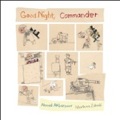 Good Night, Commander
Good Night, Commander
Written by Ahmad Akbarpour
Illustrated by Morteza Zahedi
Translated by Shadi Eskandani & Helen Mixter
Toronto, ON: Groundwood Books, 2010. 24 pp.
ISBN 978-0888999894
This picture book was published in Iran in 2005 and translated from Farsi for publication in the US and in Canada in 2010. This poignant story focuses on an Iranian boy who suffered from the Iran-Iraq war that took place between 1980 and 1988. The war resulted in the loss of one of his legs and his mother. He now spends all of his time in his room, imagining and role-playing the war that changed the course of his life forever. In his imagination, he becomes the Commander who is at the head of an army that aims at avenging his mother’s death. While his father is moving on with his life by planning to marry again, the little boy stays away from talk about this stepmother and goes into his war fantasies. The game stops when he realizes that the Iraqi soldier he is fighting is his alter ego–another kid who lost his mother and a leg in the war.
The illustrations are in a style that is child-like with simple pencil sketches on a brownish background. The only colors on the page are the bed blanket, the bulb and some toys in front of the boiler. All of them represent the boy’s room and living room as seen from above. In the story, several characters make a brief appearance: the father, the grandmother and the aunt. These characters are illustrated on page 4 and even though the story takes place after the Islamic revolution and the book was published under the latest government, no women are shown as veiled. From a cultural point of view, that makes the illustrations more authentic. In Iran, women put on the veil when they are out of the house but once they are home they take it off.
Another cultural element that caught my attention due to my own background as an Iranian occurred when the little boy’s uncles and aunts come to his house for dinner. There are pastries on the table and the boy comments “I know why.” In Iranian culture, when celebrating together, there are always pastries.
The author of Good Night, Commander, Ahmad Akbarpour, was born in 1970 which means that he was around 10 years old when the war started. The little boy in the story could be around 10. We might then wonder, whose story Ahmad Akbarpour tried to write–one of his friends or a relative? The illustrator, Morteza Zahedi, was also just a child when the war ended. Both of them must feel very close to the character in the book since they lived the war as children, just like this character. That brings even more authenticity to the story.
Good Night, Commander was written by authors who live in Iran and write about their culture for children of their culture. The book was then translated and published in the U. S. Readers sometimes struggle with constructing meaning and connecting with particular aspects of translated books because of their lack of cultural familiarity. In Good Night, Commander, it is not so much that the culture may not be understood but readers may struggle with the background history of the war. Teachers may need to do some research on the war to provide that historical context through websites such as http://en.wikipedia.org/wiki/Iran%E2%80%93Iraq_War.
Also, the structure of the book and style of storytelling may not be familiar to readers. Teachers may thus need to carefully scaffold this book for readers so they do not reject the story as strange or boring. On the other hand, this book is a powerful source of insiders’ perspectives on their own culture instead of being from the view of a visitor who writes about that culture for an American audience. Other books that teachers might pair with this book include books about children in war such as Silent Music (James Rumford, 2008) and Brothers in Hope: The Story of the Lost Boys of Sudan (Mary Williams, 2005) or another book on Iran, Persepolis (Marjane Satrapi, 2002).
Tara Hashemi, University of Arizona, Tucson, AZ
Note that an additional review of this book was published in Volume 2, Issue 4.
WOW Review, Volume V, Issue 3 by Worlds of Words is licensed under a Creative Commons Attribution-NonCommercial-ShareAlike 4.0 International License. Based on work at https://wowlit.org/on-line-publications/review/v-3/
